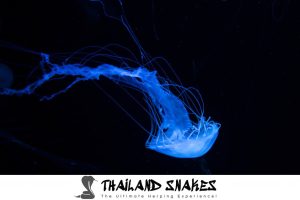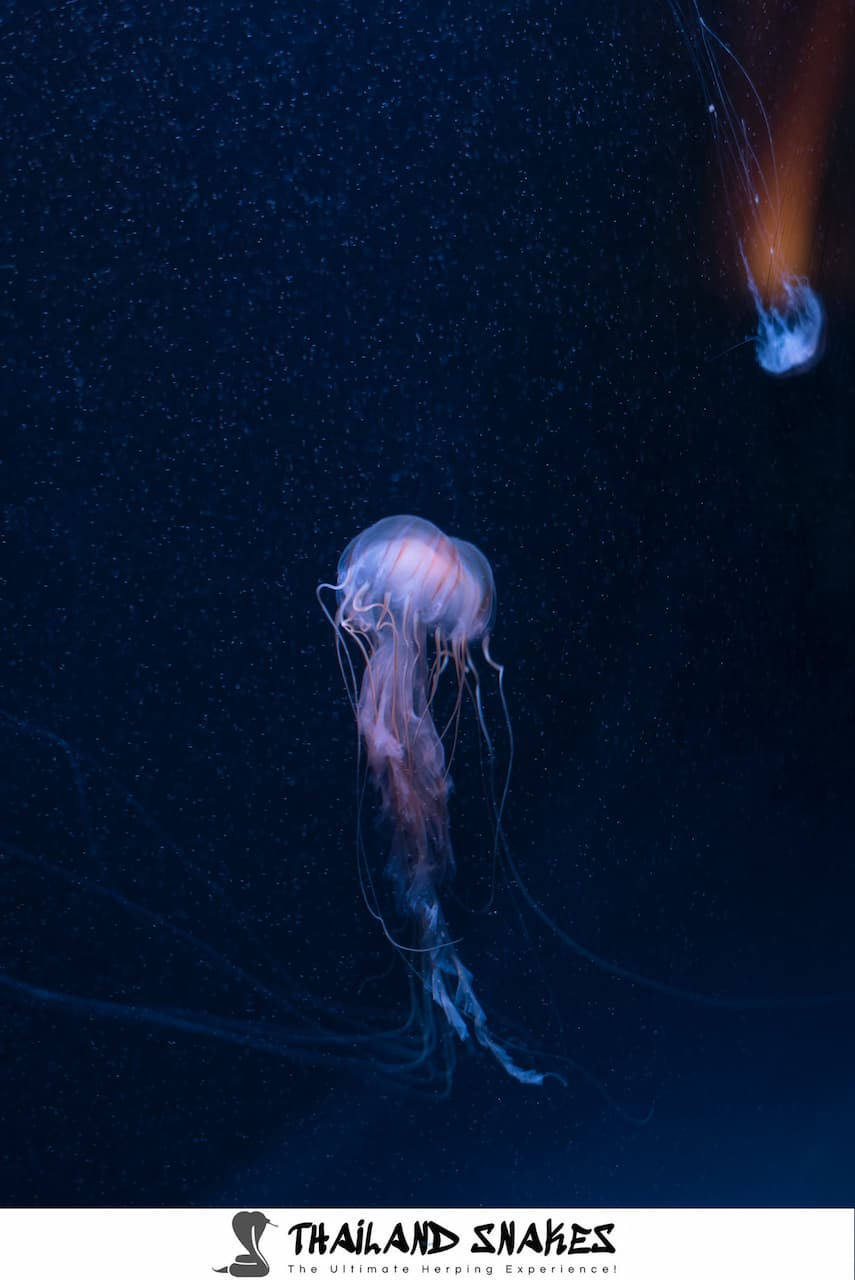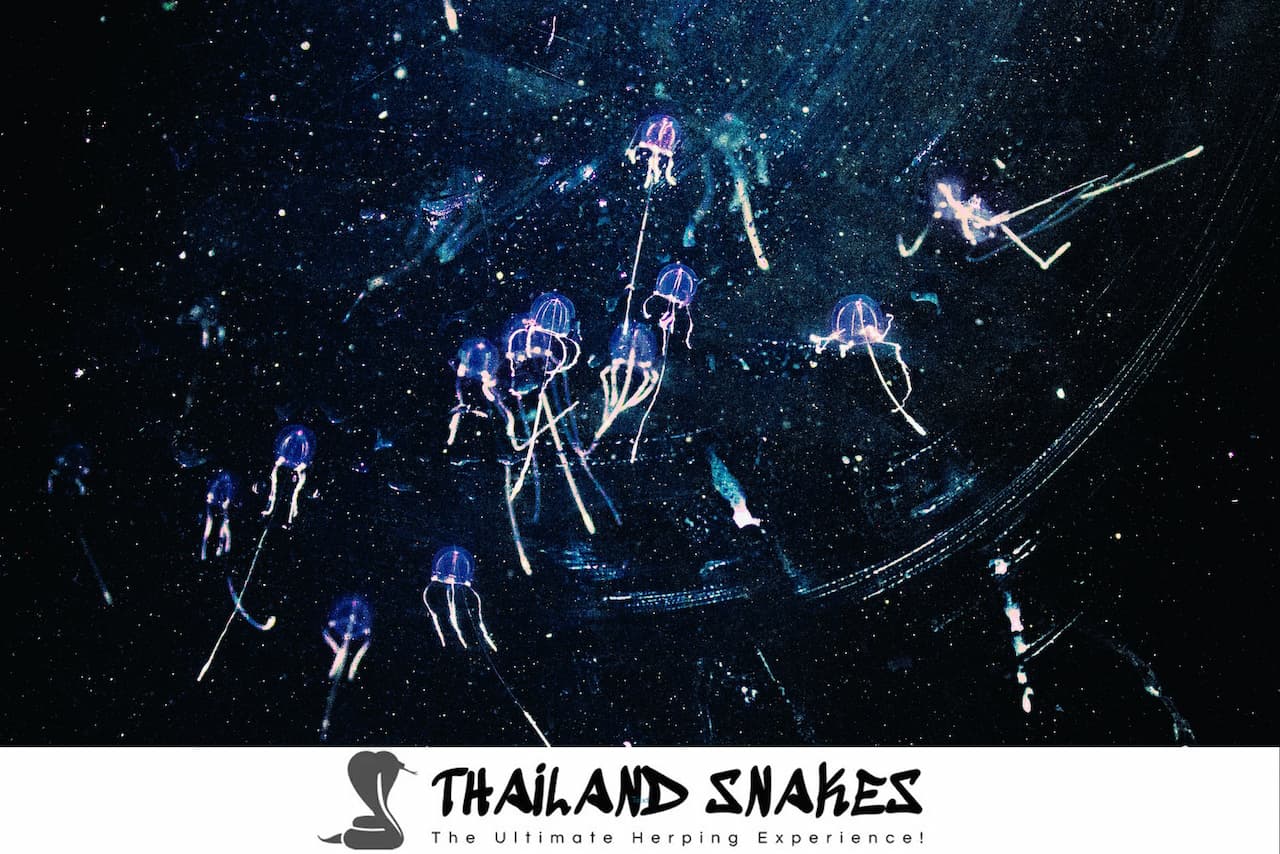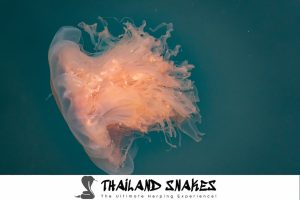Box Jellyfish Of Asia & Surrounds
The tropical and subtropical waters of Asia are home to numerous species of dangerous box jellyfish. Often called sea wasps, these invertebrates have cube or bell-shaped transparent bodies with trailing tentacles filled with extremely potent venom.
Contact with the tentacles causes agonizing stings, and some species can inflict potentially fatal toxins. Here is an overview of some of the most hazardous box jellies found around Asia.
Chironex fleckeri – Indo-Pacific Sea Wasp
The sea wasp Chironex fleckeri is widely considered the most venomous jellyfish on Earth. It inhabits the warm coastal waters of southeast Asia and northern Australia.
This formidable species has a large, cube-shaped bell that reaches up to 30 cm (12 inches) in height and width. From each corner of the bell trails a cluster of 15 tentacles that can extend 3 meters (10 feet) in length.
Chironex possesses extremely powerful venom contained in millions of stinging cells covering its tentacles. The venom contains toxins such as porins, neurotoxins, and cardiotoxins, which rapidly attack and destroy skin cells, red blood cells, the nervous system, and the heart. Even brushing against a sea wasp tentacle can inflict severe envenomation.
Upon being stung, most victims suffer immediate and excruciating pain. Red welts often form on the skin. Without rapid treatment, further symptoms rapidly progress, including nausea, vomiting, muscle cramps, numbness, shock, heart failure, paralysis, coma, and death.

Fatalities have been recorded just 2-3 minutes after contact with the sea wasp due to acute cardiac arrest. Surviving victims often need to spend days in intensive care recovering.
There have been at least 63 verified deaths due to Chironex fleckeri stings in Australia since 1884. However, the true number is difficult to confirm and likely higher due to difficulties documenting jellyfish involvement in drowning cases.
In parts of southeast Asia, such as the Philippines, sea wasp stings are greatly feared, though official fatality records are scarce.
First aid for sea wasp stings focuses on immediately dousing the sting area with vinegar. This helps deactivate unfired stinging cells, preventing them from injecting more venom. CPR and other efforts to stabilize heart and lung function are critical. Antivenoms exist but are not widely available outside major hospitals in Australia.
Chiropsalmus quadrumanus – Common Box Jellyfish
Chiropsalmus quadrumanus is another dangerous box jellyfish species found in tropical Indo-Pacific waters between Australia and Southeast Asia. It is also referred to as the sea wasp jellyfish.
This species has a transparent, cube-shaped bell measuring about 15 cm (6 inches) wide, from which sprout around 15 tentacles that can grow longer than 3 meters (10 feet).
This jellyfish inflicts very severe stings that quickly cause excruciating pain and red whip-like welts on the skin. The venom contains toxins such as hemolytic cardiotoxins and neurotoxins that damage the heart, nervous system, and skin cells.

Without immediate medical treatment, the hemotoxins can lead to heart failure and death rapidly after envenomation. Fatalities have been documented in less than 5 minutes in some cases.
Like with Chironex stings, first responders should liberally douse the sting area with vinegar for at least 30 seconds to prevent more venom injection. CPR and oxygen may be needed while waiting for an ambulance.
Long-term effects of stings may include scarring of the skin and, in some cases, cardiovascular damage.
Carukia barnesi – Irukandji Jellyfish
Carukia barnesi is a species of incredibly venomous box jellyfish found in Australia’s northern oceans near Queensland, as well as occasionally in the waters around the Philippines and Vietnam.
In spite of their very small size at just one cubic cm (0.06 cubic inches), Irukandji jellyfish possess a neurotoxin that can cause Irukandji syndrome in human victims.
Symptoms of Irukandji syndrome include severe headaches, backaches, muscle pains, nausea, vomiting, sweating, anxiety, hypertension, and potentially fatal strokes. This debilitating condition is thought to be caused by catecholamines released in response to the jellyfish venom.

Irukandji stings usually only cause a minor red mark on the skin, so many victims do not realize they have been envenomated until symptoms set in 5-40 minutes later.
Treatment for Irukandji syndrome includes administration of vinegar and antivenom medication. However, symptoms often require hospitalization in intensive care. Stings more often occur in the summer when the jellyfish tend to drift closer to shore.
Wearing sting-proof protective clothing is recommended to prevent contact with drifting Irukandjis.
Morbakka fenneri – Fire Jellyfish
Morbakka fenneri is known as the fire jellyfish due to the potent, painful stings it can inflict on humans. It inhabits the shallow coastal waters, lagoons, and estuaries of southeast Asia and northern Australia.
These small jellyfish have transparent, box-shaped bells reaching about 8 inches (20 cm) in diameter, with around 15 long, slender trailing tentacles below.
Contact with a fire jellyfish tentacle causes rapid, painful stinging and raised red welts on the skin in a characteristic zig-zag pattern. More severe stings may cause symptoms like nausea, vomiting, muscle cramps, numbness, headache, and weakness.

While the venom is not considered deadly, it can still produce severe reactions in sensitive individuals.
As with most jellyfish stings, liberal application of vinegar to deactivate unfired stingers is recommended. Removal of any adhering tentacles helps prevent more envenomation.
Assessment of neurological status, monitoring of breathing, and first aid for other symptoms may be warranted in severe cases until the sting effects resolve.
Malo kingi – Kings Box Jellyfish
Malo kingi is a large and dangerous box jellyfish species found in the tropical Indo-Pacific waters between northern Australia and southeastern Asia. It is named in honor of Robert King, an early jellyfish researcher.
These jellyfish have thick, 10-sided medusas growing over 30 cm (1 foot) in diameter. From each corner, extend between 13-15 tentacles that can reach 3 meters (9 feet) long.
This jellyfish inflicts very painful stings that cause severe local and systemic symptoms. The skin is marked by raised, red, whip-like welts.
Pain spreads from the wound, along with profuse sweating and drooling. Nausea, vomiting, muscle cramps, headache, weakness, and breathing issues manifest rapidly.
Although Malo kingi stings have not yet resulted in verified human fatalities, they can still be severely life-threatening if not treated. Antivenom is available in some areas.
Rapid deactivation of stingers with vinegar and supportive medical care provide the best prognosis. Full recovery can take over a week due to the extreme pain.
Carybdea alata – Hawaiian Box Jellyfish
Carybdea alata goes by the common name Hawaiian box jellyfish due to its prevalence in the waters surrounding Hawaii and Guam. It also inhabits shallow saltwater lagoons, bays, and shores across much of the tropical Indo-Pacific.
The adults have a translucent, somewhat flattened cubic medusa that grows up to about 7.5 cm (3 inches) in diameter. Just below hang 4 short tentacles armed with stinging cells.
This jellyfish species inflicts moderately painful stings that cause symptoms including red whip-like skin welts, nausea, vomiting, muscle cramps, headache, abdominal pain, anxiety, weakness, and potentially respiratory distress for sensitive individuals. Serious complications are rare but can become life-threatening.
Prompt rinsing with vinegar can help limit venom exposure and damage by preventing more stinging cells from firing their toxins.
Analgesics and medical monitoring are advised for more severe reactions. Wearing protective clothing and avoiding swimming with box jellies present limited stinging risk.
Carybdea rastonii – Jimble or Rastonia Box Jellyfish
Carybdea rastonii is a small species of box jellyfish found primarily around Malaysia, the Philippines, Indonesia, Papua New Guinea, and Borneo. It goes by several common names, including jimble jellyfish and Rastonia.
The mature jellyfish has a cubic, translucent bell that grows up to about 2.5 cm (1 inch) wide, with short tentacles sprouting from each of its four lower corners.
The jimble’s sting causes immediate pain and raised, itchy red welts on the skin. Rashes, swelling, and dermatitis may occur if the victim has an allergic sensitivity.
In severe stings, symptoms like muscle cramps, nausea, headache, anxiety, vomiting, weakness, and difficulty breathing can manifest and require emergency medical care.
Although no fatalities have been definitively linked to this species, the stings warrant caution and first aid. Liberal vinegar rinse of the sting area prevents further venom exposure.
Antihistamines and painkillers may relieve milder symptoms, while hospitalization is advised for respiratory distress or swallowing difficulties.
Copula sivickisi – Borneo Box Jellyfish
Copula sivickisi is a small type of box jellyfish endemic to the waters surrounding Borneo. It inhabits shallow coastal waters, harbors, bays, and lagoons.
The jellyfish has a tiny, transparent cubic bell measuring just 1 cm (0.4 inches) across. From each of its four lower corners extends a short-stalked tentacle equipped with stinging cells.
This jellyfish inflicts a moderately painful sting that causes raised red welts and inflamed marks on the skin.
More severe envenomations result in painful muscle cramps, headaches, weakness, trembling, nausea, vomiting, and potentially respiratory distress. Serious complications are possible in sensitive individuals.
As with most jellyfish stings, thorough rinsing with vinegar is recommended to prevent further firing of stingers and limit venom dose.
Analgesics can relieve pain, while medications may be required if breathing issues arise. Sting victims should be monitored for potentially life-threatening allergic reactions. Protective clothing helps prevent stings.
Chirodropus gorilla – Giant Box Jellyfish
Chirodropus gorilla is a massive and impressive species of box jellyfish found in tropical west Pacific waters off Japan, Korea, China, Malaysia, and the Philippines.
It earns its common name ‘giant jellyfish’ from its enormous size, with incredibly wide and thick bells reaching over 1 meter (3 feet) in diameter and thick contractile tentacles growing to over 15 meters (50 feet) long!
Thankfully, this behemoth jellyfish does not seem to produce severely venomous stings, rating around a two on a 4-point scale.
Still, its huge sweeping tentacles allow it to inflict painful lashes. Sting symptoms include intense dermal pain, red welts on the skin, headaches, muscle cramps, weakness, nausea, and potential vomiting. First-aid vinegar rinse and analgesics can help treat the discomfort.
This massive jelly’s size and moderate sting make it more of an object of awe and wonder rather than a severe life threat for humans.
However, its huge form allows it to deliver much more significant stings to smaller swimmers unable to evade its far-reaching tentacles. Caution is still warranted around these gentle giants.
Habitat and Behavior
Box jellyfish inhabit tropical and subtropical coastal waters, lagoons, bays, and estuaries throughout the Indo-Pacific region. They prefer warm, shallow water environments and are most abundant near sandy beaches and reef systems.
Jellyfish densities fluctuate seasonally based on spawning cycles, ocean currents, and food availability.
Box jellies exhibit complex visual orientation and actively swim to stay near shore and in preferred habitats. They are carnivorous, feeding primarily on small fish, shrimp, and crustaceans that become caught on their tentacles.
Polyps attached to seafloor substrates asexually bud off young jellyfish into the water column, where they grow and sexually reproduce to create more medusa.
Jellyfish blooms often form during warm summer months or after seasonal monsoon rains in tropical zones. This coincides with peaks in jellyfish stings. Avoiding swimming during local jellyfish seasons reduces sting risk.
However, changing climate conditions may expand habitat ranges and bloom seasons for some jelly species in the future.
Preventing and Treating Stings
Here are some tips for preventing painful box jellyfish stings and administering first aid treatment if stung:
- Wear full-body protective swimwear, gloves, boots, and headgear when swimming in areas box jellies are known to inhabit. Sting-resistant materials include neoprene, lycra, spandex, and pantyhose.
- Apply protective skin creams or oils which may inhibit nematocyst firing. However, do not rely solely on these for prevention.
- Carefully look for jellies and avoid swimming in areas where they are visible. Leave water immediately if jellies are noticed. Avoid night swimming when some species are most active.
- Do not touch jellyfish remains on shore. Even recently dead specimens can sting.
- If stung, immediately exit the water and remove any tentacles stuck to the skin using gloves, sticks, towels, or other aids. Take care not to contact tentacles directly.
- Generously douse affected areas with vinegar for at least 30 seconds. This inactivates unfired nematocysts and limits venom dose. Do not rinse with seawater or freshwater.
- Call emergency services for rapid medical assistance, even if the pain seems minor at first. Monitor breathing and circulation. Start CPR if needed.
- Further treatment, including antivenoms, pain control, cardiac support, and observation in intensive care may be necessary. Resuscitation equipment should be readily available.
Proper first-aid response training and the availability of lifesaving equipment help reduce the risk of fatalities from box jelly stings.
Public awareness campaigns can help beachgoers recognize and avoid these hazardous jellies. With caution and appropriate treatment, even serious box jellyfish stings can often be survived.
FAQs
How dangerous are box jellyfish stings?
Box jellyfish stings can be extremely hazardous, depending on the species. The most venomous types, like the sea wasp, can induce cardiac arrest and death within minutes.
Rapid first aid is essential to prevent the worst outcomes. Even less toxic species can cause intense pain, scarring, and other severe reactions.
What species of box jellyfish are most dangerous?
The Indo-Pacific sea wasp (Chironex fleckeri) is considered the world’s most venomous jellyfish. It can inflict lethal stings that cause cardiac arrest in minutes.
Other hazardous species include Chiropsalmus quadrumanus, Carukia barnesi (Irukandji jellyfish), Malo kingi, and Carybdea alata. The severity of stings varies between species based on differences in venom toxicity.
However, any box jellyfish sting warrants caution and prompt first aid treatment. Wearing full-body protective swimwear is recommended when swimming in known box jellyfish waters.
What should I do if stung by a box jellyfish?
If stung, immediately exit the water and remove any adhering tentacles with gloves/towels to avoid direct contact. Generously rinse the affected skin with vinegar for at least 30 seconds to deactivate unfired stingers.
Call emergency responders right away, even if the pain seems minor at first. Monitor breathing and circulation, perform CPR if needed, and get hospital treatment for significant stings.
How can I reduce my risk when swimming in jellyfish waters?
Wear full protective swimwear of sting-resistant materials like neoprene or lycra. Look for jellyfish and leave the water if spotted. Avoid swimming at night or during seasons of high jellyfish abundance.
Apply protective creams that may inhibit stinging. Never touch jellyfish, even beached ones. Know first aid protocols in case of a sting.
Conclusion
Box jellyfish present serious hazards for oceangoers across tropical Asia. Their powerful stinging cells can induce agony, scarring, and even rapid death without proper first aid.
However, by understanding their biology and following preventative measures, ocean enthusiasts can continue enjoying the region’s beautiful beaches and waters more safely.
Caution, preparation, and prompt response, if stung, give box jellyfish victims the best chances for a full recovery.
